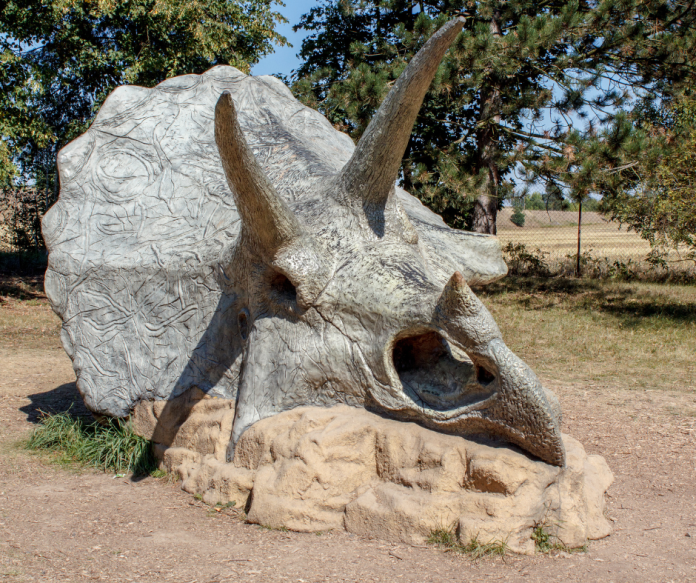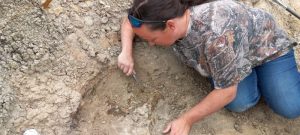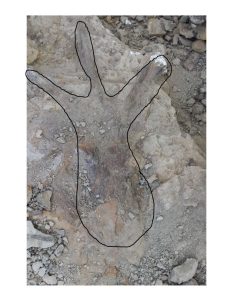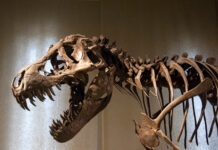
Triceratops dinosaur fossils are among the most iconic finds in paleontology, and my recent expedition uncovered more of these ancient giants in the Badlands near Baker, Montana.
I recently returned from an expedition to what I now call the Valley of the Triceratops in the Badlands near Baker, Montana. This was unlike any other adventure so far, as the rain came fairly early and the temperature never rose to more than 81 degrees, which is quite unusual for the area. Nonetheless, it was outstanding digging.
What Is a Triceratops Dinosaur?
Triceratops horridus is a dinosaur that got its name because of its head. “Tri” is the word for three, and “Ceratops” is the word for horn face. “Horridus” means horrible. Its name means horrible three-horned face. Not a bad description.

Journey to the Montana Fossil Site
I call this area the Valley of the Triceratops because as we prospected and walked around our area, we found the badly weathered remains of a triceratops dinosaur and more have been found in the same valley.
Like my first adventure digging for dinosaurs over 17 years ago, we traversed the Badlands in four-wheel drive vehicles. Then we traveled a road that the dig master himself called the “road of death.” Near the end of the trail was a hill with a severe downslope that I didn’t even want to think about. As we entered the Valley of the Triceratops, we had to descend into the valley floor through a cattle gate and then down a road in name only. There were ruts, boulders and the angle was, shall I say, steep.
Once we reached the dig site, some seven miles into the valley, we unloaded and then walked about 100 yards to the hillside where bones were recently found. They were part of the frill, the large shield at the back of the skull, and one horn of the Triceratops dinosaur that was found a year before. They were badly weathered but still could be prepared and displayed.
The crew from last year had removed a great deal of dirt and rock that was over some of the bones. Our mission was to plaster jacket the frill, which was in two large pieces, remove a rib and vertebrae and continue to excavate for the crew following us later in the summer.

Excavating and Preserving the Fossils
The crew of nine, including my daughter PaleoJen, worked the site and also exposed what she called rib spaghetti, a massive jumble of ribs. There were also two other bones and another two vertebrae exposed.
We concentrated on the frill and brow horn section for two days. They both needed to be jacketed and removed. Jacketing a part of the frill was quite a chore. We first exposed as much as we could, creating a pedestal. Then we soaked pre-cut burlap strips in a plaster mixture we mixed onsite. The next step was to put tin foil on the piece as a parting agent, making it easier to remove the jacket later. Wrapping the larger burlap strips around the outer margin of the frill piece secured the tin foil. Then strips were laid on top of the frill and crisscrossed to provide stability to the fossil.
Transporting Triceratops Dinosaur Fossils to a Museum
The fossil block was very heavy and bulky, so we attached 2 x 4 lumber with strips of burlap just as we did to wrap the frill. Once everything had dried, the block was rolled over and the heavy work of taking the block to the truck began.
Four of us grabbed each corner and two other team members stood between the sides to steady the load. We walked as far as we could and set the block down, repeating the process about halfway. Then it was decided to try to make the terrain easier to traverse, so we leveled some small hills and removed some vegetation.
From Dig Site to Museum Display
We successfully loaded it onto the truck and sent it to the prep lab to be cleaned and repaired for museum display. It’s always a pleasure and privilege to be involved with bringing 65-million-year-old fossils to a museum where they can be enjoyed by the public.
Triceratops dinosaur fossils continue to shed light on the ancient ecosystems of the Late Cretaceous. Each discovery helps paleontologists better understand this iconic three-horned dinosaur, its environment, and its role in history. Fossil digs like this one make it possible for museums to share the story of Triceratops with the world.
This story about digging for Triceratops dinosaur fossils previously appeared in Rock & Gem magazine. Click here to subscribe! Story and photos by Joseph “PaleoJoe” Kchodl.














